Research on Droplets Deposition Characteristics of Anti-Drift Spray Device with Multi-Airflow Synergy Based on CFD Simulation
Abstract
:1. Introduction
2. Materials and Methods
2.1. Device Structure and Working Principle
2.1.1. Structure of the Device
2.1.2. Working Principle
2.2. Droplet Dynamics Analysis in Multi-Airflow Synergy
2.2.1. Droplet Force Analysis
2.2.2. Model of Droplet Motion in Space
- (a)
- Construction of motion model
- (b)
- Solution of motion model
2.3. Simulation Method
2.3.1. Geometric Model
2.3.2. Design of Simulation
2.4. Design of Experiments
3. Results and Discussion
3.1. Influence of Operating Parameters on Droplet Movement
3.1.1. Spray Pressure
3.1.2. V-Shaped Wind Speed
3.2. Droplets Deposition Characteristics
3.2.1. Droplet Drift Angle
3.2.2. Simulation of the Influence of Different Factors on Droplets Deposition
- (a)
- Influence of crosswind wind speed on droplet deposition
- (b)
- Influence of V-shaped wind speed on droplet deposition
- (c)
- Influence of spray pressure on droplet deposition
3.2.3. Prediction Model of the Drift Distance of the Droplets Deposition Center
3.3. Measurement of the Predicted Drift Distance of the Droplets Deposition Center
4. Conclusions
- (1)
- There are still many droplets leaving the canopy and drifting loss, which results in pesticide waste and environmental pollution. A V-shaped anti-drift spray device in multi-airflow synergy was designed according to modern orchards with low root stock in a high-density planting. The two auxiliary air ducts are arranged in a V shape in the horizontal direction. The droplet’s spatial motion model was constructed based on the particle dynamics analysis, and the anti-drift mechanism of multi-airflow synergy was clarified. The influences of spray pressure and V-shaped wind speed on the droplets’ movement were illuminated by Matlab. When the V-shaped wind speed ranges from 15 m/s to 25 m/s, the anti-drift effect of the machine is better;
- (2)
- A simulation model of the flow field between the spray device and the fruit trees canopy was constructed by the method of CFD. By considering crosswind speed, V-shaped wind speed, and spray pressure and using partial multivariate orthogonal regression, three-level simulation experiments of the droplets’ deposition were designed. The influence of V-shaped wind speed on the spatial distribution of droplets was analyzed, which indicated that the three factors had a significant influence on the droplet deposition characteristics, and the degree from big to small was V-shaped wind speed, crosswind speed, spray pressure. The prediction model of the drift distance of the droplets deposition center was constructed, its fitting degree is high, and the correlation coefficient is 0.998;
- (3)
- The experiments on the machine were carried out. The results show that when the crosswind speed, the spray pressure, and V-shaped wind speed are 2.2 m/s, 0.52 MPa, and 20.8 m/s, respectively, the droplet drifting rate was 29.2% lower than that of single-airflow. The drifting distance of the droplet deposition center is 5.0 cm, which is consistent with the prediction model. The research can provide a basis for the design and parameters optimization of the similar sprayers used in modern orchards with low root stock in a high-density planting.
Author Contributions
Funding
Institutional Review Board Statement
Informed Consent Statement
Conflicts of Interest
References
- National Bureau of Statistics of the People’s Republic of China. China Statistical Yearbook 2020[R]; China Statistics Press: Beijing, China, 2020. Available online: http://www.stats.gov.cn/tjsj/ndsj/ (accessed on 1 June 2022). (In Chinese)
- Zhao, Y.; Xiao, H.; Mei, S.; Song, Z.; Ding, W.; Jin, Y.; Han, Y.; Xia, X.; Yang, G. Current status and development strategies of orchard mechanization production in China. J. China Agric. Univ. 2017, 22, 116–127. (In Chinese) [Google Scholar]
- Zheng, J.; Xu, Y. Development and prospect in environment-friendly pesticide sprayers. Trans. Chin. Soc. Agric. Mach. 2021, 52, 1–16. (In Chinese) [Google Scholar]
- Xiang, D.; Tie, Z.; Mingde, Y. Design and experiment of 3WPZ-4 type air-assisted grape sprayer. Trans. Chin. Soc. Agric. Mach. 2018, 49, 205–213. (In Chinese) [Google Scholar]
- Foqué, D.; Pieters, J.G.; Nuyttens, D. Spray deposition and distribution in a bay laurel crop as affected by nozzle type, air assistance and spray direction when using vertical spray booms. Crop Prot. 2012, 41, 77–87. [Google Scholar] [CrossRef]
- Jin, X.; Dong, X.; Yang, X.J. Design and experiment of target spraying system of 3WGZ-500 sprayer. Trans. Chin. Soc. Agric. Mach. 2016, 47, 21–27. (In Chinese) [Google Scholar]
- Nestor Circular Sprayer [EB/OL]. Available online: https://www.agriexpo.cn/prod/weremczuk-fmr-sp-z-o-o/product-170611-17417.html (accessed on 2 October 2020).
- ASIA TECH Self-Propelled Pneumatic Sprayer [EB/OL]. Available online: https://www.agriexpo.cn/prod/asia-technologyco-ltd/product-180444-55544.html (accessed on 2 October 2020).
- Salcedo, R.; Zhu, H.; Zhang, Z.; Wei, Z.; Chen, L.; Ozkan, E.; Falchieri, D. Foliar deposition and coverage on young apple trees with PWM-controlled spray systems. Comput. Electron. Agric. 2020, 178, 105794. [Google Scholar] [CrossRef]
- Zheng, Y.J.; Chen, B.T.; Lyu, H.T.; Kang, F.; Jiang, S.J. Research progress of orchard plant protection mechanization technology and equipment in China. Trans. Chin. Soc. Agric. Eng. 2020, 36, 110–124. (In Chinese) [Google Scholar]
- Li, X.; Wang, P.; Li, J.; Yang, Y.; Bian, Y. A comparative study on the spraying effect of orchard wind sprayers under different air supply modes. J. Fruit Sci. 2020, 37, 1065–1072. (In Chinese) [Google Scholar]
- Li, B. Present situation and technical requirements of apple dwarf stock cultivation in China. Deciduous Fruits 2020, 52, 1–3. (In Chinese) [Google Scholar]
- da Cunha, J.P.; Reis, E.F.D.; de Assunção, H.H.; Landim, T.N. Evaluation of droplet spectaa of the spray TIP AD 11002 using different techniques. Eng. Agric. 2019, 39, 476–481. [Google Scholar]
- Griesang, F.; Decaro, R.A.; dos Santos, C.A.M.; Santos, E.S.; de Lima Roque, N.H.; da Costa Ferreira, M. How much do adjuvant and nozzles models reduce the spraying drift? Drift in agricultural spraying. Am. J. Plant Sci. 2017, 8, 2785–2794. [Google Scholar] [CrossRef] [Green Version]
- Al Heidary, M.; Douzals, J.P.; Sinfort, C.; Vallet, A. Influence of spray characteristics on potential spray drift of field crop sprayers: A literature review. Crop Prot. 2014, 63, 120–130. [Google Scholar] [CrossRef]
- Chen, Y.; Hou, C.; Tang, Y.; Zhuang, J.; Lin, J.; Luo, S. An effective spray drift-reducing method for a plant-protection unmanned aerial vehicle. Int. J. Agric. Biol. Eng. 2019, 12, 14–20. [Google Scholar] [CrossRef]
- De Cock, N.; Massinon, M.; Salah, S.O.; Lebeau, F. Investigation on optimal spray properties for ground based agricultural applications using deposition and retention models. Biosyst. Eng. 2017, 162, 99–111. [Google Scholar] [CrossRef] [Green Version]
- Felsot, A.S.; Unsworth, J.B.; Linders, J.B.; Roberts, G.; Rautman, D.; Harris, C.; Carazo, E. Agrochemical spray drift; assessment and mitigation—A review. Pestic. Food Contam. Agric. Wastes 2010, 45, 889–911. [Google Scholar] [CrossRef]
- Palleja, T.; Landers, A.J. Electro-leaf, a biomimicry system to estimate in-canopy airflow in fruit crops. Comput. Electron. Agric. 2016, 127, 606–614. [Google Scholar] [CrossRef]
- Salcedo, R.; Pons, P.; Llop, J.; Zaragoza, T.; Campos, J.; Ortega, P.; Gallart, M.; Gil, E. Dynamic evaluation of airflow stream generated by a reverse system of an axial fan sprayer using 3D-ultrasonic anemometers. Effect of canopy structure. Comput. Electron. Agric. 2019, 163, 104851. [Google Scholar] [CrossRef]
- Qiu, W.; Sun, H.; Sun, Y.H. Design and test of circulating air-assisted sprayer for dwarfed orchard. Trans. Chin. Soc. Agric. Eng. 2021, 37, 18–25. (In Chinese) [Google Scholar]
- Jun, H.; Changxi, L.; Xin, C. Droplet deposition characteristics of conical wind field anti-drift device. Trans. Chin. Soc. Agric. Mach. 2020, 51, 142–149, 174. (In Chinese) [Google Scholar]
- Calomino, F.; Alfonsi, G.; Gaudio, R.; D’Ippolito, A.; Lauria, A.; Tafarojnoruz, A.; Artese, S. Experimental and numerical study of free-surface flows in a corrugated pipe. Water 2018, 10, 638. [Google Scholar] [CrossRef] [Green Version]
- Abbas, N.; Rehman, K.U.; Shatanawi, W.; Malik, M.Y. Numerical study of heat transfer in hybrid nanofluid flow over permeable nonlinear stretching curved surface with thermal slip. Int. Commun. Heat Mass Transf. 2022, 135, 106107. [Google Scholar] [CrossRef]
- Hong, S.W.; Zhao, L.; Zhu, H. CFD simulation of airflow inside tree canopies discharged from air-assisted sprayers. Comput. Electron. Agric. 2018, 149, 121–132. [Google Scholar] [CrossRef]
- Lan, Y.; Shengde, C.; Fritz, B.K. Current status and future trends of precision agricultural aviation technologies. Int. J. Agric. Biol. Eng. 2017, 10, 1–17. [Google Scholar]
- Duga, A.T.; Delele, M.A.; Ruysen, K.; Dekeyser, D.; Nuyttens, D.; Bylemans, D.; Nicolai, B.M.; Verboven, P. Development and validation of a 3D CFD model of drift and its application to air-assisted orchard sprayers. Biosyst. Eng. 2016, 154, 62–75. [Google Scholar] [CrossRef]
- García-Ramos, F.J.; Malón, H.; Aguirre, A.J.; Boné, A.; Puyuelo, J.; Vidal, M. Validation of a CFD model by using 3D Sonic Anemometers to analyse the air velocity generated by an air-assisted sprayer equipped with two axial fans. Sensors 2015, 15, 2399–2418. [Google Scholar] [CrossRef] [Green Version]
- Nadeem, S.; Amin, A.; Abbas, N. On the stagnation point flow of nanomaterial with base viscoelastic micropolar fluid over a stretching surface. Alex. Eng. J. 2020, 59, 1751–1760. [Google Scholar] [CrossRef]
- Hong, S.W.; Zhao, L.; Zhu, H. SAAS, a computer program for estimating pesticide spray efficiency and drift of air-assisted pesticide applications. Comput. Electron. Agric. 2018, 155, 58–68. [Google Scholar] [CrossRef]
- Bahlol, H.Y.; Chandel, A.K.; Hoheisel, G.A.; Khot, L.R. The smart spray analytical system: Developing understanding of output air-assist and spray patterns from orchard sprayers. Crop Prot. 2020, 127, 104977. [Google Scholar] [CrossRef]
- Fan, G.; Niu, C.; Zhang, Z.; Wang, D.; Mao, W.; Jiang, H. Design and experiment of V-shaped orchard anti-drift spray device with multi-airflow cooperation. Trans. Chin. Soc. Agric. Mach. 2022, 53, 138–147. (In Chinese) [Google Scholar]
- Zhao, L.; Guoqiang, F.; Guangming, W.; Hao, D.; Xiaohui, Z. Distribution model of wind-stressed droplet deposition based on bimodal distribution. Trans. Chin. Soc. Agric. Mach. 2020, 51, 28–37. [Google Scholar]
- Fritz, B.K.; Hoffmann, W.C.; Bagley, W.E.; Kruger, G.R.; Czaczyk, Z.; Henry, R.S. Measuring droplet size of agricultural spray nozzles-measurement distance and airspeed effects. Atom. Sprays 2014, 24, 747–760. [Google Scholar] [CrossRef] [Green Version]
- Jiyu, L.; Lan, Y.; Jianwei, W.; Shengde, C.; Cong, H.; Qi, L.; Qiuping, L. Distribution law of rice pollen in the wind field of small UAV. Int. J. Agric. Biol. Eng. 2017, 10, 32–40. [Google Scholar] [CrossRef]
- NY/T 2849-2015 Technical Specifcations of Application for Air-Assisted Sprayers; Ministry of Agriculture and Rural Affairs of the People’s Republic of China: Beijing, China, 2015.
- Lauria, A.; Alfonsi, G.; Tafarojnoruz, A. Flow pressure behavior downstream of ski jumps. Fluids 2020, 5, 168. [Google Scholar] [CrossRef]
- Tafarojnoruz, A.; Lauria, A. Large eddy simulation of the turbulent flow field around a submerged pile within a scour hole under current condition. Coast. Eng. J. 2020, 62, 489–503. [Google Scholar] [CrossRef]
- Khan, A.A.; Abbas, N.; Nadeem, S.; Shi, Q.H.; Malik, M.Y.; Ashraf, M.; Hussain, S. Non-Newtonian based micropolar fluid flow over nonlinear starching cylinder under Soret and Dufour numbers effects. Int. Commun. Heat Mass Transf. 2021, 127, 105571. [Google Scholar] [CrossRef]
- Abbas, N.; Nadeem, S.; Saleem, A. Computational analysis of water based Cu-Al2O3/H2O flow over a vertical wedge. Adv. Mech. Eng. 2020, 12, 1687814020968322. [Google Scholar] [CrossRef]
- Zhang, H.Y.; Lan, Y.B.; Wen, S.; Xu, T.; Yu, F. Research progress in rotor airflow model of plant protection UAV and droplet motion mechanism. Trans. Chin. Soc. Agric. Eng. 2020, 36, 1–12. [Google Scholar]
- Ren, X.; Yu, X. Multivariate Statistical Analysis; China Statistics Press: Beijing, China, 2010; Volume 12, p. 393.
- Ding, S.; Xue, X.; Dong, X.; Gu, W.; Zhou, Q. Effects of spraying parameters on droplet deposition performance. Trans. Chin. Soc. Agric. Mach. 2020, 51, 308–315. [Google Scholar]
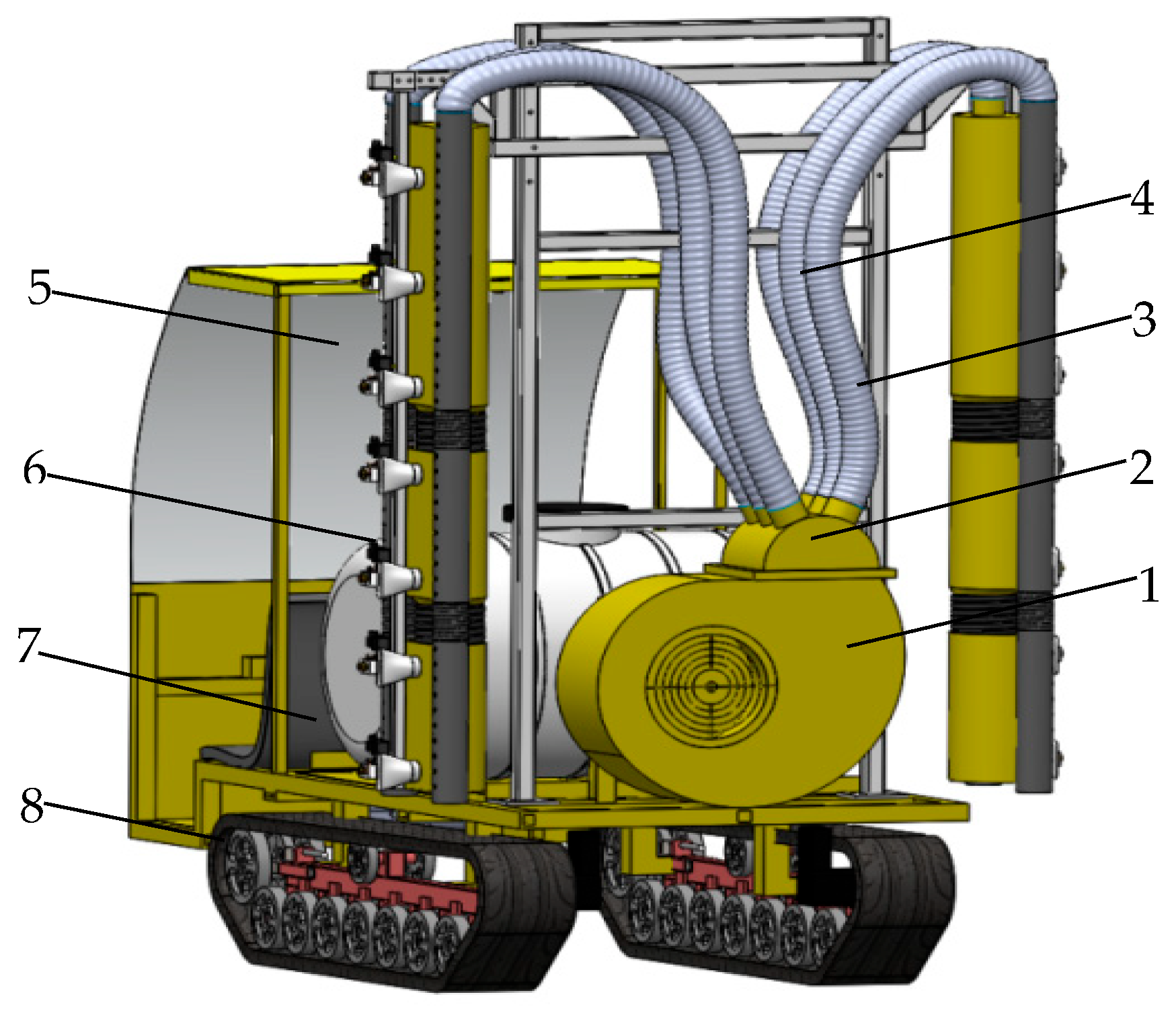
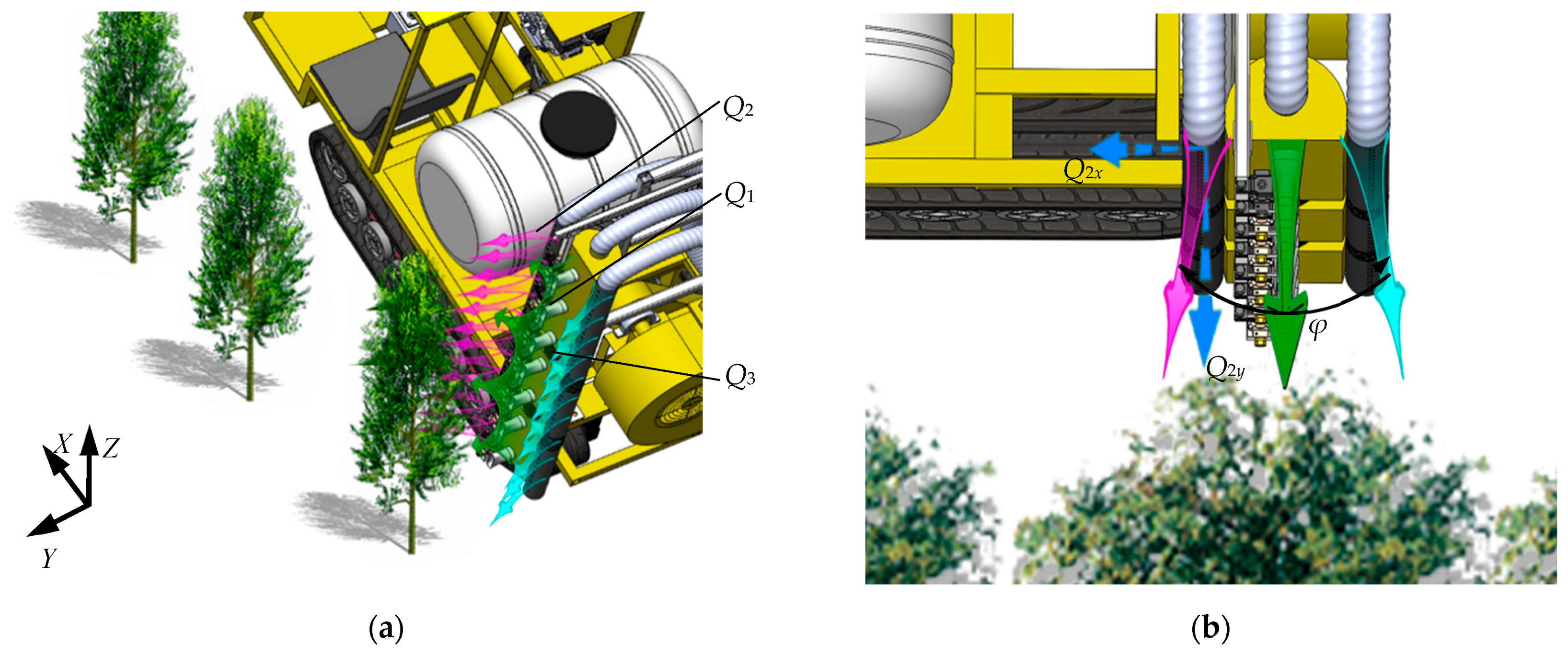
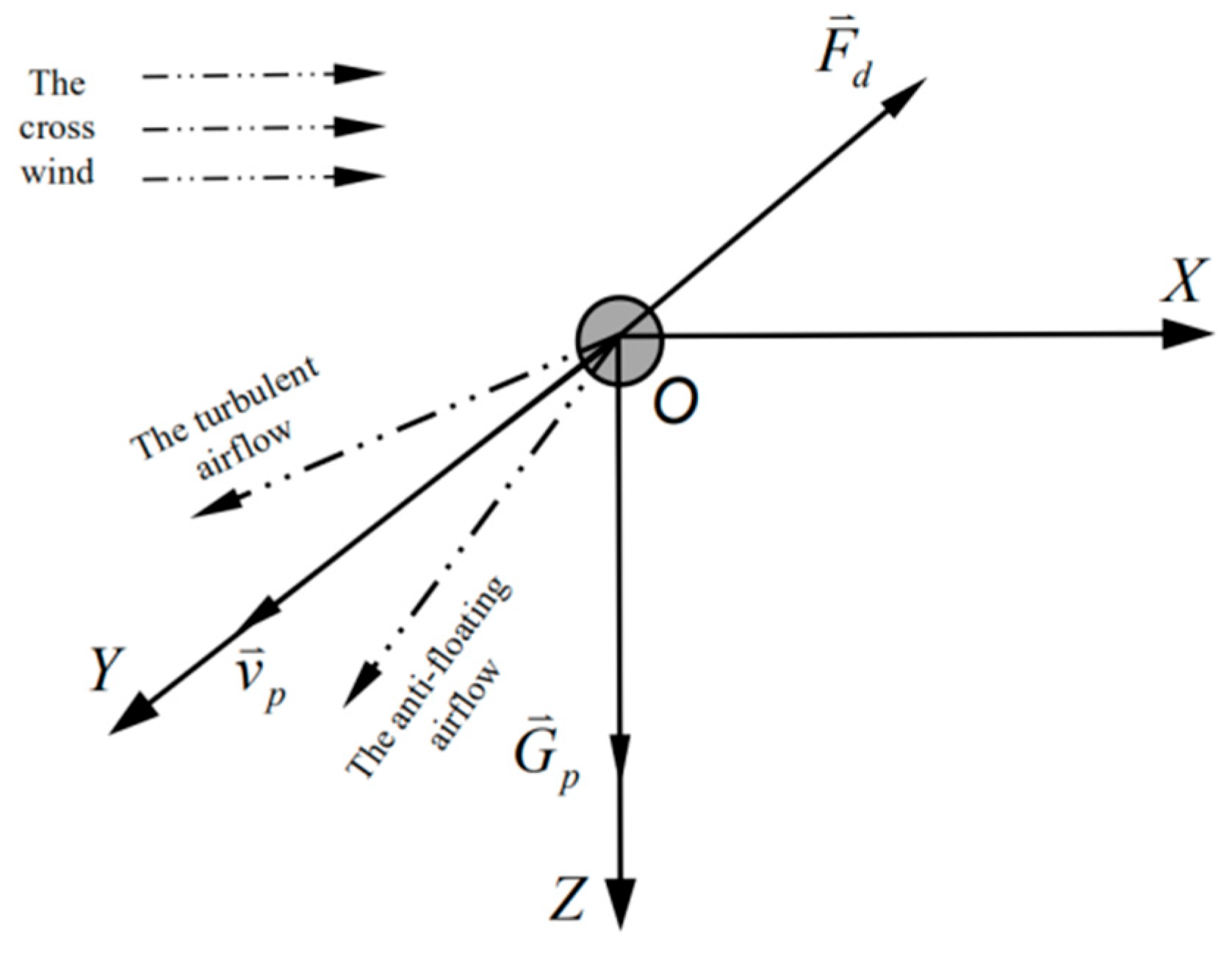
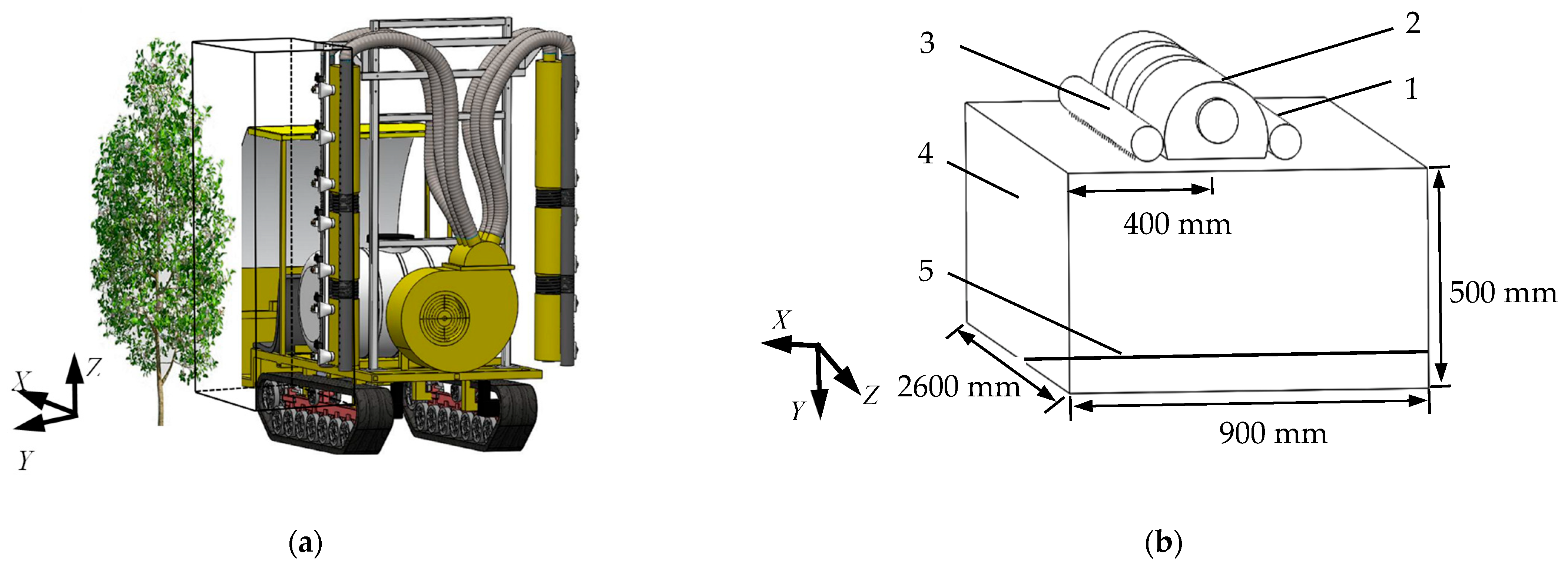

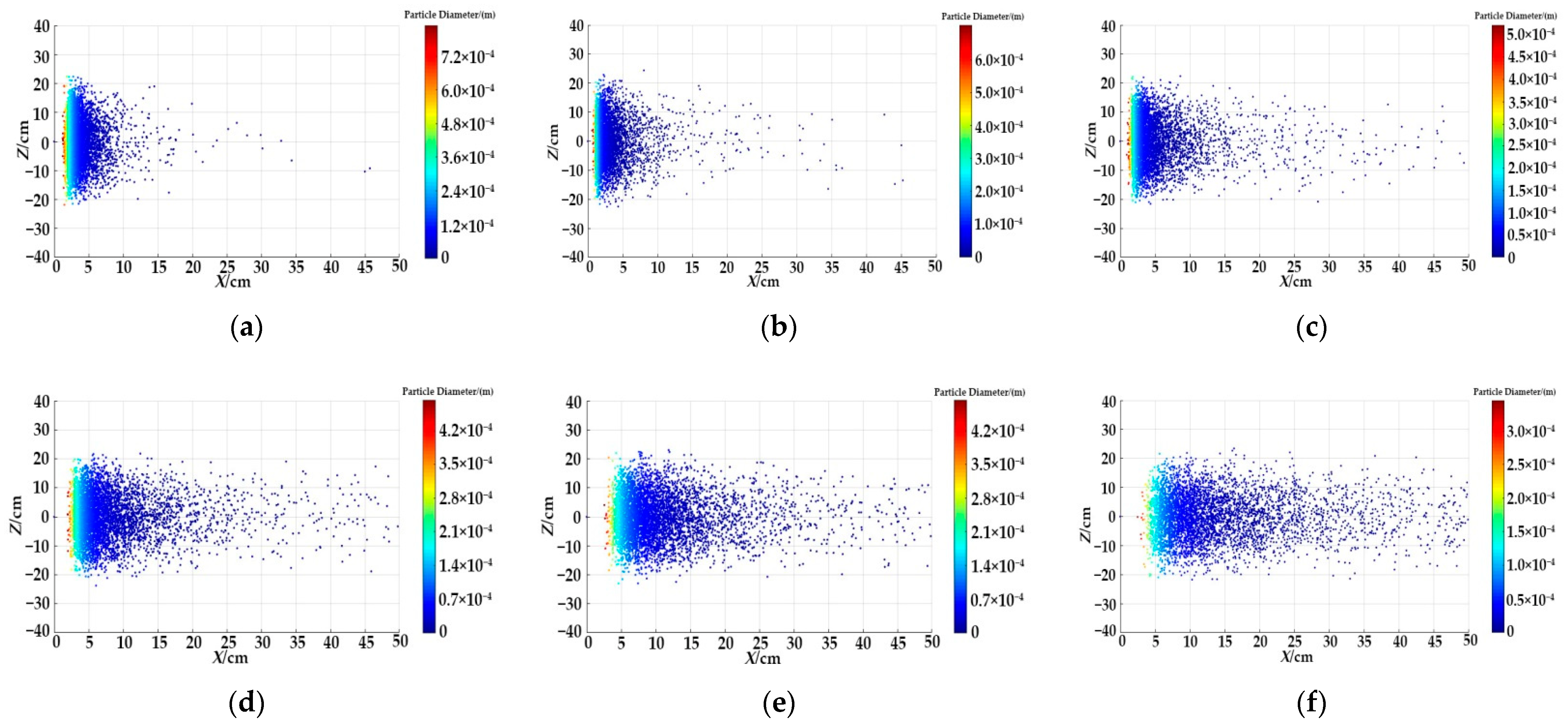
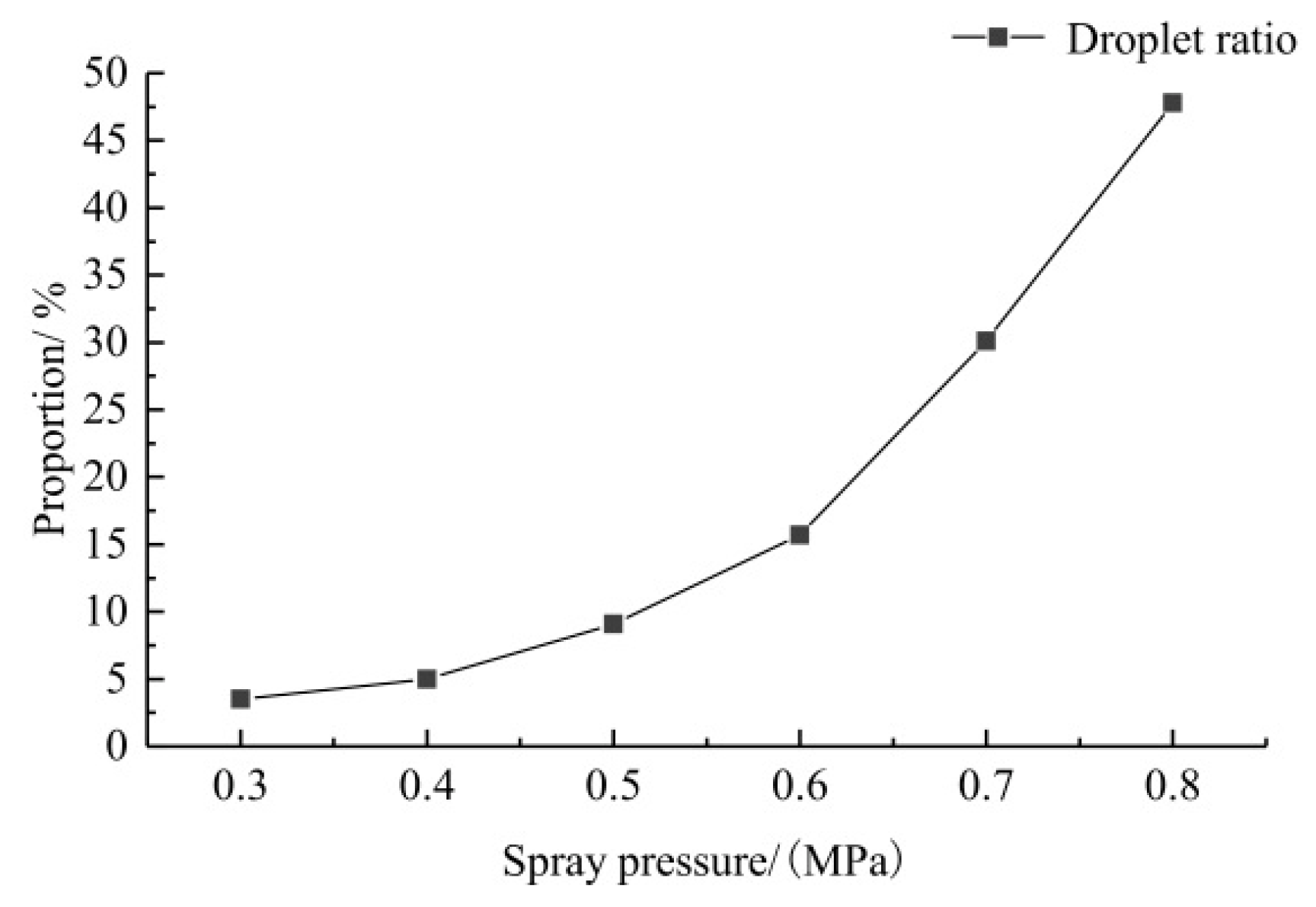


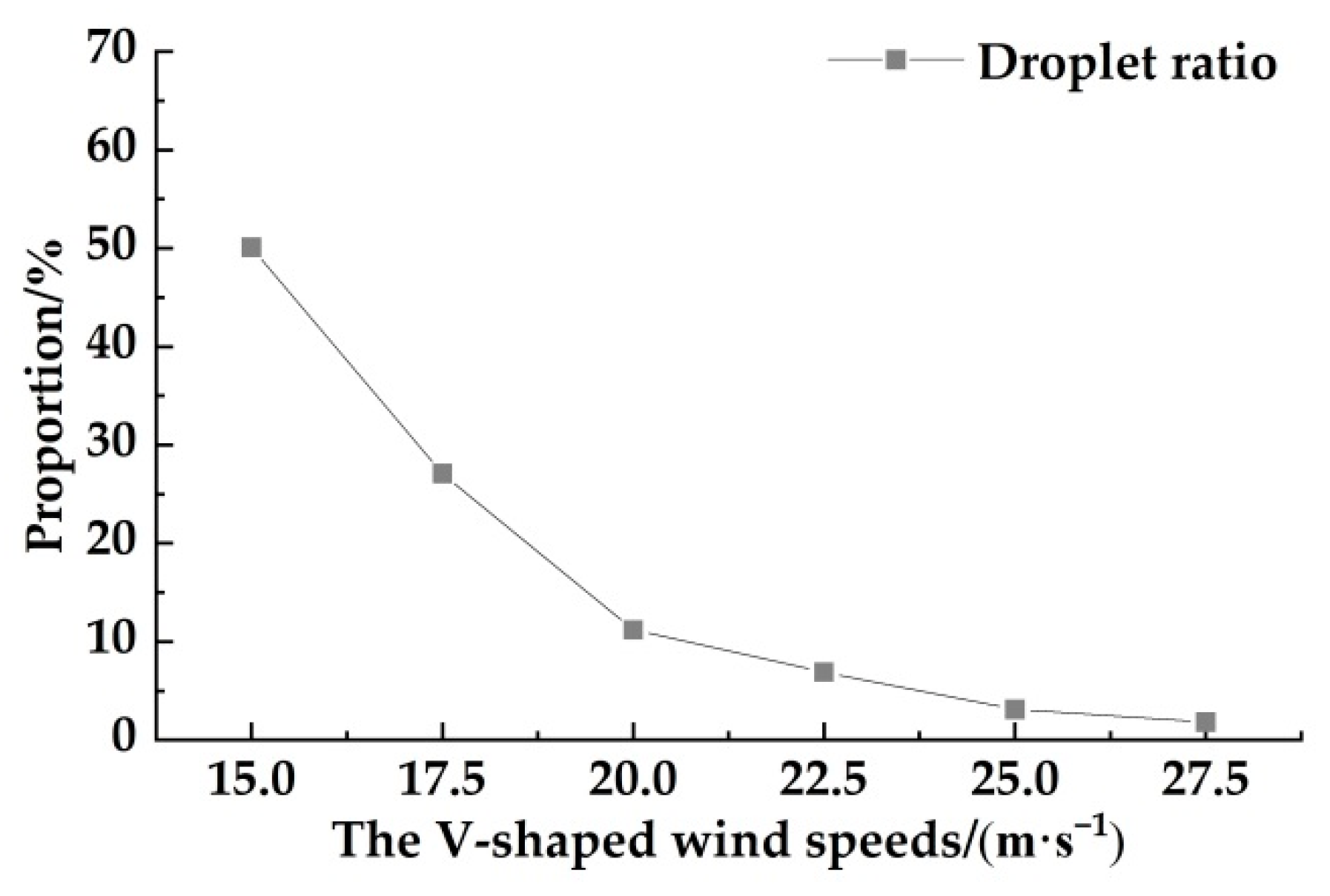

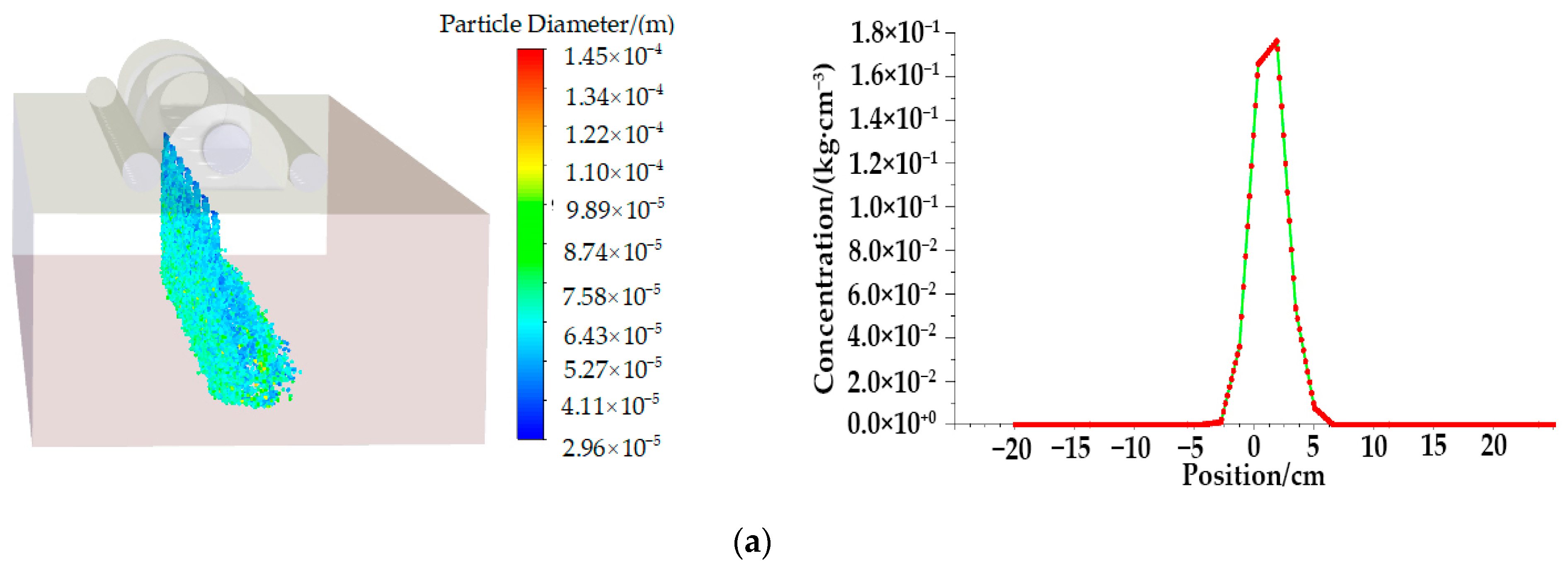
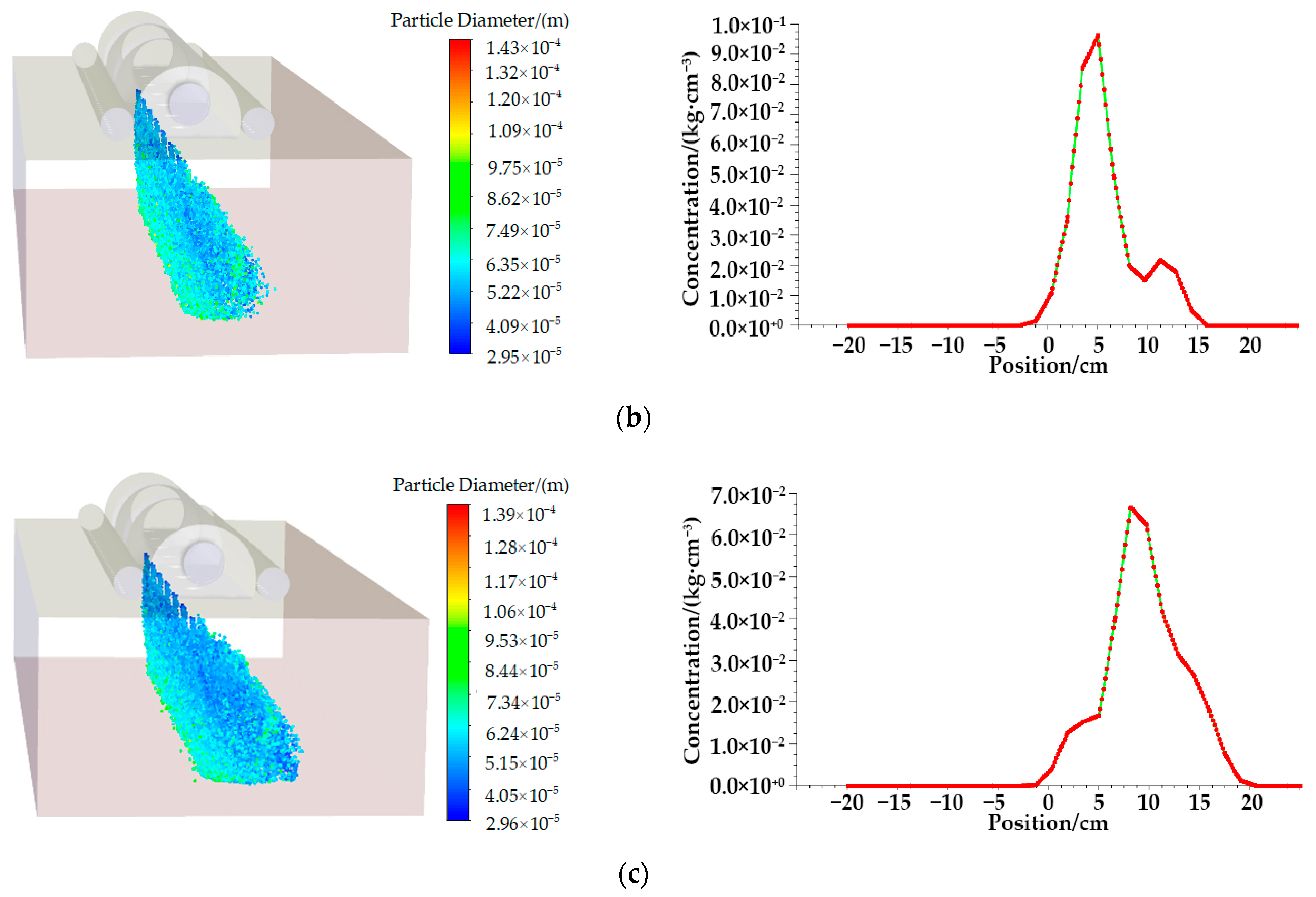

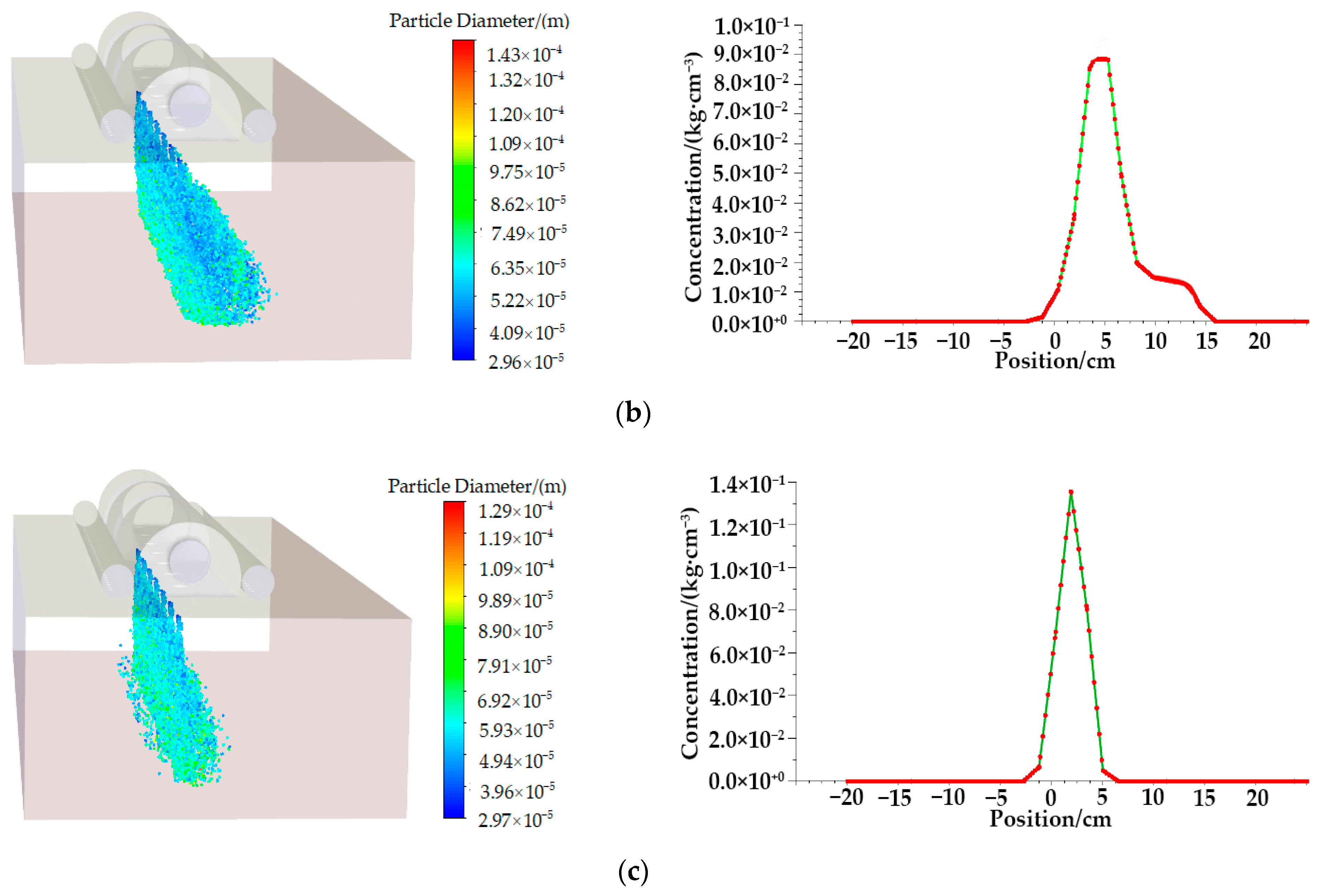

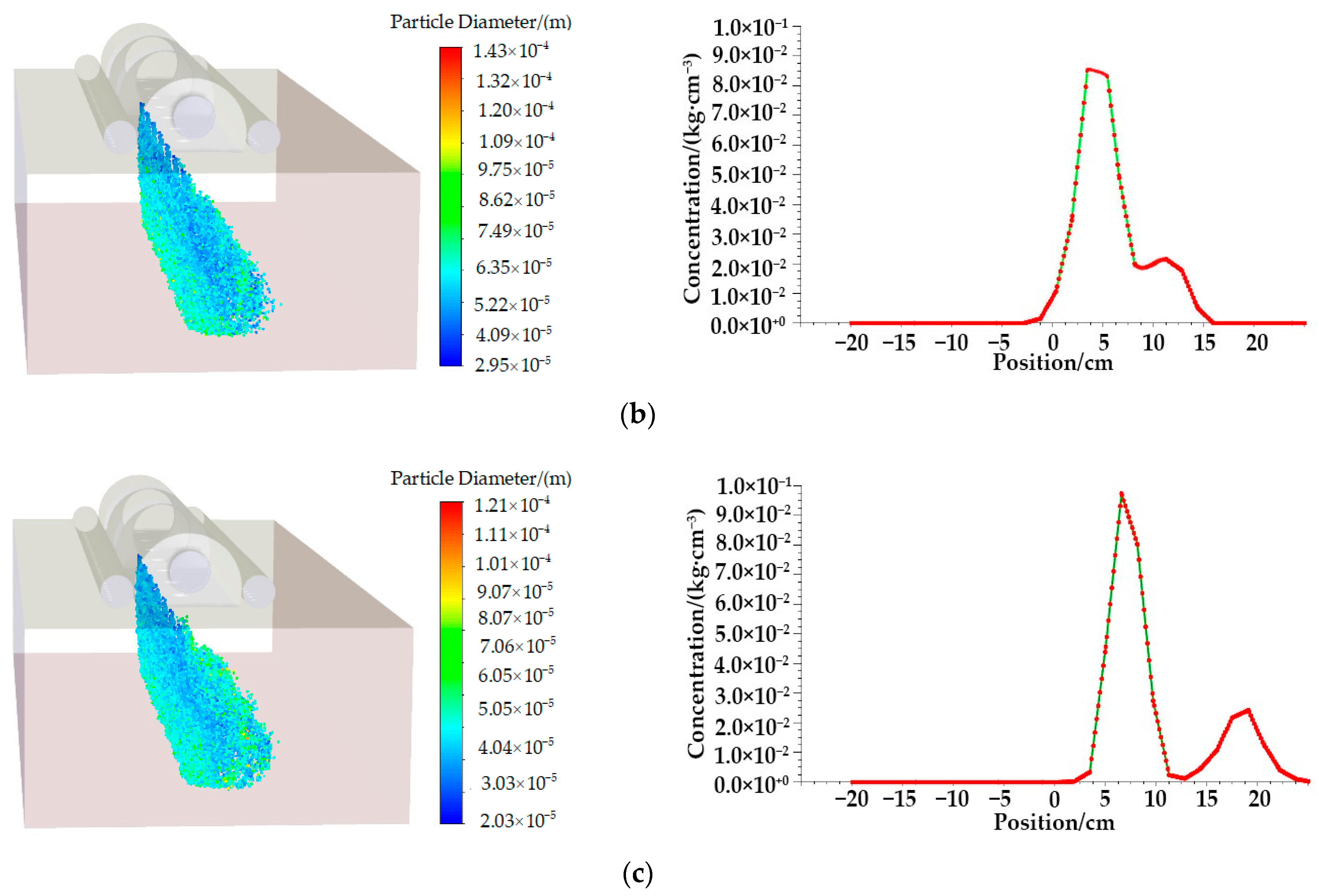
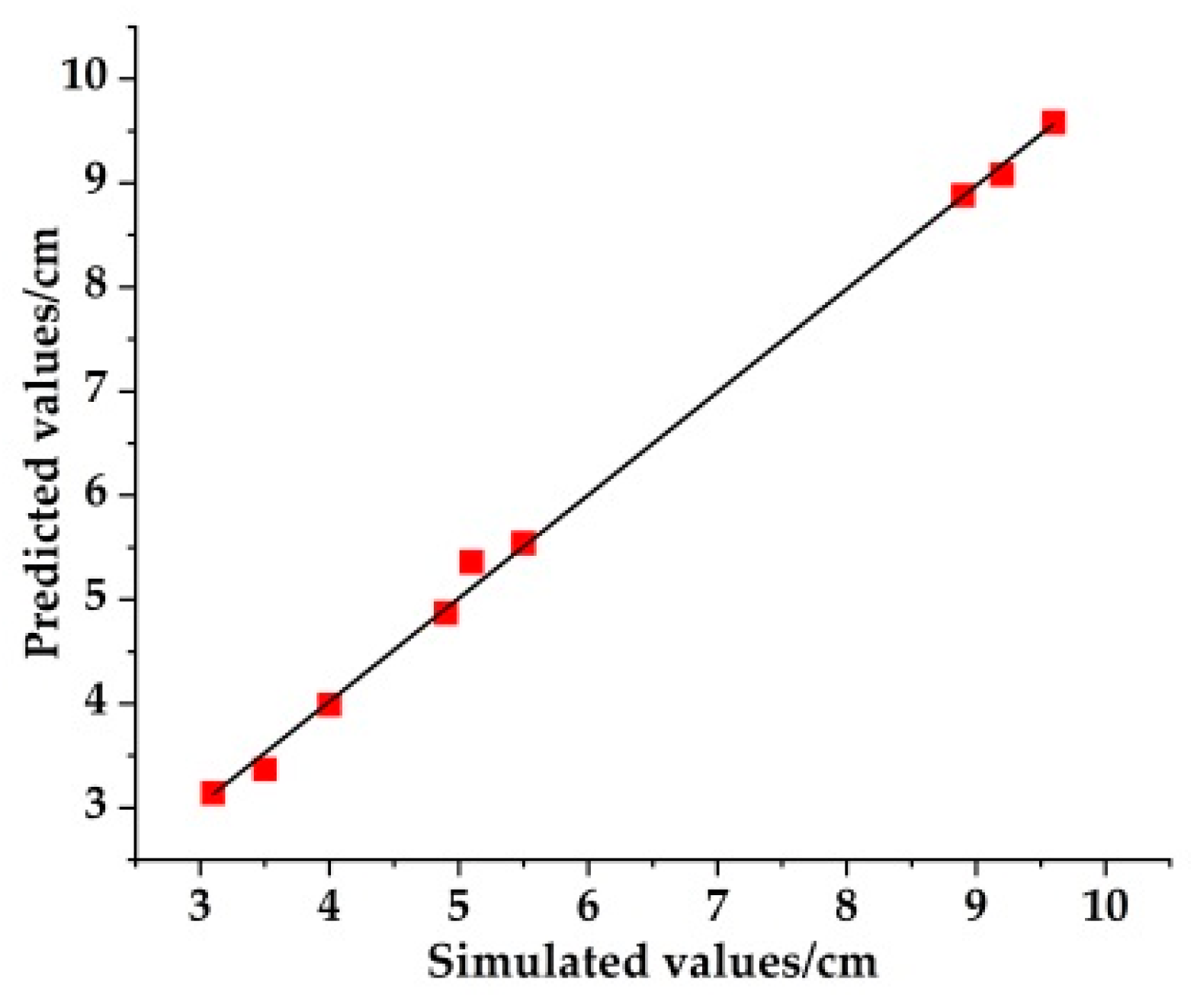
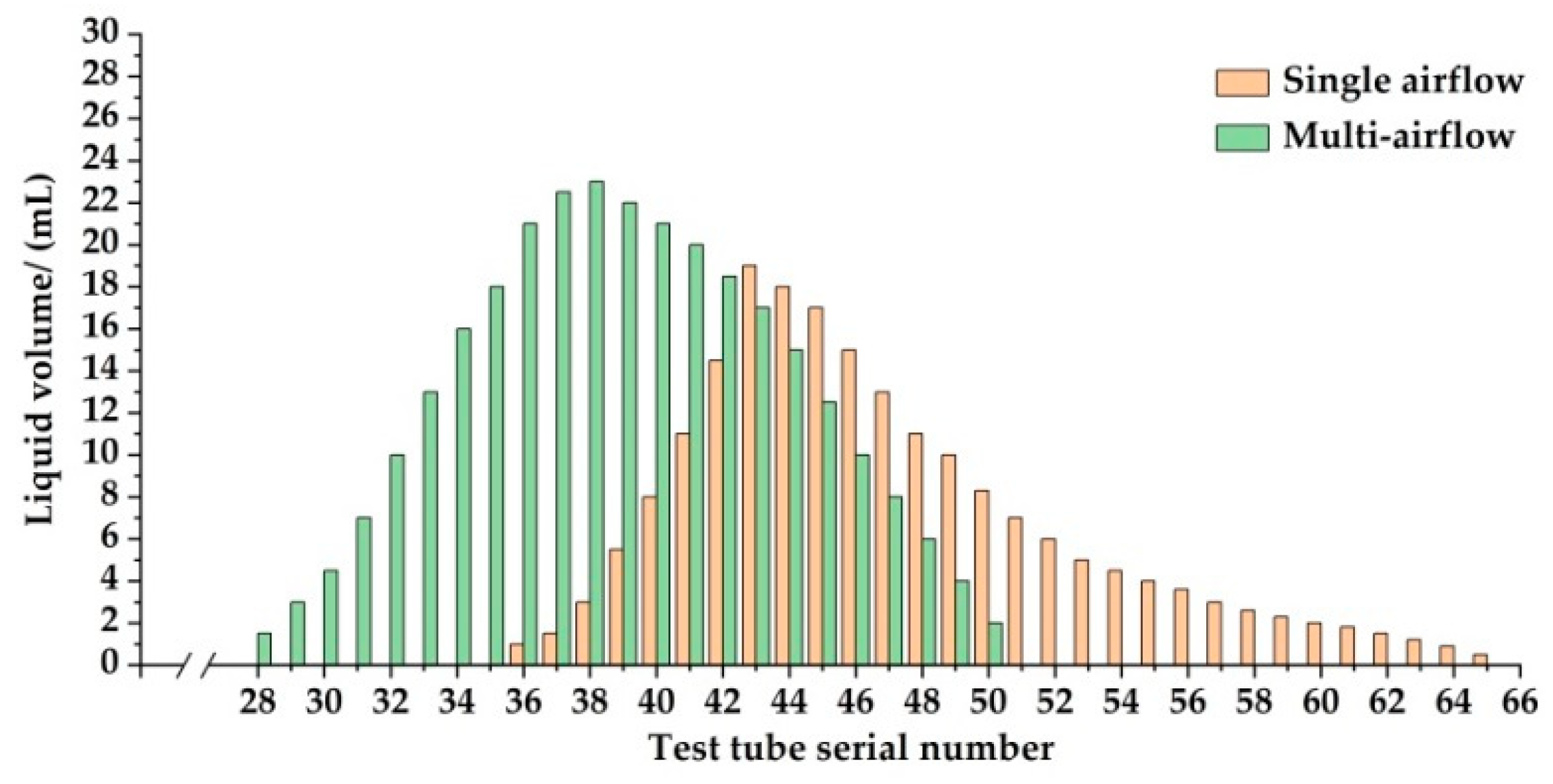

| Parameter Name (Unit) | Value |
|---|---|
| X-Fan Normal Vector | 1 |
| Y-Fan Normal Vector | 0 |
| Z-Fan Normal Vector | 0 |
| Flow Rate (kg/s) | 0.01316 |
| Spray Half Angle (deg) | 40 |
| Orifice Width (m) | 0.00091 |
| Flat Fan Sheet Constant | 3 |
| Atomizer Dispersion Angle (deg) | 6 |
| Cross Wind Speed (m/s) | 1 | 2 | 3 | ||||||
|---|---|---|---|---|---|---|---|---|---|
| V-Shaped Wind Speed (m/s) | 1 | 2 | 3 | 1 | 2 | 3 | 1 | 2 | 3 |
| Spray Pressure (MPa) | |||||||||
| 1 | A11 | A21 | A31 | B11 | B21 | B31 | C11 | C21 | C31 |
| 2 | A12 | A22 | A32 | B12 | B22 | B32 | C12 | C22 | C32 |
| 3 | A13 | A23 | A33 | B13 | B23 | B33 | C13 | C23 | C33 |
| Exp. No. | Test Factor | Deposition Center Drift Distance | ||
|---|---|---|---|---|
| A(x1) | B(x2) | C(x3) | Y (cm) | |
| 1 | 1(2) | 1(15) | 1(0.4) | 8.9 |
| 2 | 1 | 2(20) | 2(0.5) | 4.9 |
| 3 | 1 | 3(25) | 3(0.6) | 3.1 |
| 4 | 2(3) | 1 | 2 | 9.2 |
| 5 | 2 | 2 | 3 | 5.1 |
| 6 | 2 | 3 | 1 | 3.5 |
| 7 | 3(4) | 1 | 3 | 9.6 |
| 8 | 3 | 2 | 1 | 5.5 |
| 9 | 3 | 3 | 2 | 4.0 |
| y1 | 5.63 | 9.23 | 5.97 | Priority: B > A > C |
| y2 | 5.93 | 5.17 | 6.03 | |
| y3 | 6.37 | 3.53 | 5.93 | |
| Ry | 0.73 | 5.70 | 0.10 | |
| Exp. No. | x1 | x2 | x3 | Z0(x1) | Z1(x1) | Z2(x1) | Z1(x2) | Z2(x2) | Z1(x3) | Z2(x3) | y (cm) | y2 |
|---|---|---|---|---|---|---|---|---|---|---|---|---|
| 1 | 1 | 1 | 1 | 1 | −1 | 1 | −1 | 1 | −1 | 1 | 8.9 | 79.21 |
| 2 | 1 | 2 | 2 | 1 | −1 | 1 | 0 | −2 | 0 | −2 | 4.9 | 24.01 |
| 3 | 1 | 3 | 3 | 1 | −1 | 1 | 1 | 1 | 1 | 1 | 3.1 | 9.61 |
| 4 | 2 | 1 | 2 | 1 | 0 | −2 | −1 | 1 | 0 | −2 | 9.2 | 84.64 |
| 5 | 2 | 2 | 3 | 1 | 0 | −2 | 0 | −2 | 1 | 1 | 5.1 | 26.01 |
| 6 | 2 | 3 | 1 | 1 | 0 | −2 | 1 | 1 | −1 | 1 | 3.5 | 12.25 |
| 7 | 3 | 1 | 3 | 1 | 1 | 1 | −1 | 1 | 1 | 1 | 9.6 | 92.16 |
| 8 | 3 | 2 | 1 | 1 | 1 | 1 | 0 | −2 | −1 | 1 | 5.5 | 30.25 |
| 9 | 3 | 3 | 2 | 1 | 1 | 1 | 1 | 1 | 0 | −2 | 4.0 | 16.00 |
| Coefficient | Z0 | Z1(x1) | Z2(x1) | Z1(x2) | Z2(x2) | Z1(x3) | Z2(x3) | ||
|---|---|---|---|---|---|---|---|---|---|
| Dj | 9 | 6 | 18 | 6 | 18 | 6 | 18 | 53.80 | 374.14 |
| Bj | 53.80 | 2.20 | 0.40 | −17.10 | 7.30 | −0.10 | −0.50 | S = 52.54 f = 8 | |
| bj | 5.98 | 0.37 | 0.02 | −2.85 | 0.41 | −0.02 | −0.03 | ||
| Sj | 321.72 | 0.81 | 0.01 | 48.74 | 2.99 | 0.00 | 0.02 | ||
Publisher’s Note: MDPI stays neutral with regard to jurisdictional claims in published maps and institutional affiliations. |
© 2022 by the authors. Licensee MDPI, Basel, Switzerland. This article is an open access article distributed under the terms and conditions of the Creative Commons Attribution (CC BY) license (https://creativecommons.org/licenses/by/4.0/).
Share and Cite
Fan, G.; Wang, S.; Bai, P.; Wang, D.; Shi, W.; Niu, C. Research on Droplets Deposition Characteristics of Anti-Drift Spray Device with Multi-Airflow Synergy Based on CFD Simulation. Appl. Sci. 2022, 12, 7082. https://doi.org/10.3390/app12147082
Fan G, Wang S, Bai P, Wang D, Shi W, Niu C. Research on Droplets Deposition Characteristics of Anti-Drift Spray Device with Multi-Airflow Synergy Based on CFD Simulation. Applied Sciences. 2022; 12(14):7082. https://doi.org/10.3390/app12147082
Chicago/Turabian StyleFan, Guiju, Siyu Wang, Peng Bai, Dongwei Wang, Wenjie Shi, and Chengqiang Niu. 2022. "Research on Droplets Deposition Characteristics of Anti-Drift Spray Device with Multi-Airflow Synergy Based on CFD Simulation" Applied Sciences 12, no. 14: 7082. https://doi.org/10.3390/app12147082
APA StyleFan, G., Wang, S., Bai, P., Wang, D., Shi, W., & Niu, C. (2022). Research on Droplets Deposition Characteristics of Anti-Drift Spray Device with Multi-Airflow Synergy Based on CFD Simulation. Applied Sciences, 12(14), 7082. https://doi.org/10.3390/app12147082






